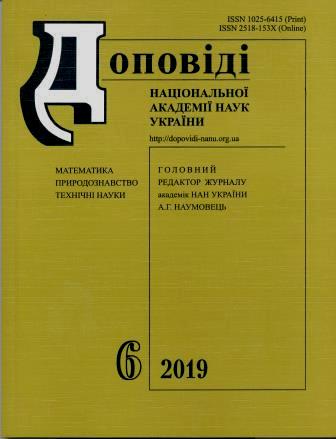Магнітні властивості карбіду NiCx з дефектною структурою типу сфалериту
DOI:
https://doi.org/10.15407/dopovidi2019.06.036Ключові слова:
карбіди NiCx, магнітна сприйнятливість, магнітний момент, механохімічний синтез, температура КюріАнотація
Досліджено магнітну сприйнятливість нанорозмірного карбіду NiCx (x ≤ 0,33) із дефектною кубічною струк- турою типу сфалериту (а = 0,3549 нм), синтезованого методом механохімічного сплавлення суміші порош- ків нікелю та багатостінних вуглецевих нанотрубок в високоенергетичному кульовому планетарному млині. Виявлено двостадійний характер експериментальних політерм магнітної сприйнятливості χ(T). Встановле но, що тривалість розмелювання вихідної шихти Ni-ВНТ в високоенергетичному кульовому млині супроводжує- ться зміною магнітних характеристик, зокрема збільшенням парціального парамагнітного моменту та тем- ператури Кюрі досліджуваного матеріалу. Виявлений ефект пояснюється тим, що під час механохімічної ак ти- вації при утворенні кристалічної ґратки карбіду NiCx атоми вуглецю в ній частково заповнюють те тра едричні пустоти вихідної нікелевої ґратки, поступово руйнуючи певні зв’язки Ni–Ni, збільшуючи при цьому число електронів із неспареними спінами, які визначають парамагнітні характе ристики одержаного матеріалу.
Завантаження
Посилання
Abaeva, L. F., Shumskyi, V. I., Petritskaya, E. N. et. al. (2010). Nanoparticles amd nanotechnologies in medicine today and tomorrow. Almanakh klinich. meditsiny, 22, pp. 10-6 (in Russian).
Mamonova, I. A. & Babushkina, I. V. (2012). Experimental study of antibacterial action of nickel nanoparticles on Pseudomonas aeruginosa clinical strains. Fundamentalnye issledovaniya, No. 1-2, pp. 174-178 (in Russian). Retrieved from http://fundamental-research.ru/ru/article/view?id=29422
Murzagaleev, Т. М., Vosmerikov, A. V., Golovko, A. K. et.al. (2011). Heavy oil cracking in the presence of nickel nanopowders. Neftepererabotka I neftehimiya. Nauchno-tehnichiskie dostizheniya I peredovoy opyt, No. 4, pp. 11-13 (in Russian).
Yue, L., Sabiryanov, R., Kirkpatrick, E. M. & Leslie-Pelecky, D. L. (2000). Magnetic properties of disordered Ni3C. Phys. Rev. B, 62(13), 8969. doi: https://doi.org/10.1103/PhysRevB.62.8969
Nakonechna, О. І., Belyavina, N. N., Dashevskyi, M. M., Kurylyuk, A. M. & Makara, V. A. (2019). Mechanochemical synthesis of NiCx carbide with the sphalerite-type defect structure Dopov. Nac. akad. nauk. Ukr., No. 4, pp. 50-56 (in Ukrainian). doi: https://doi.org/10.15407/dopovidi2019.04.050
Fonseca, F. C., Goya, G. F., Jardim, R. F., Muccillo, R., Carreno, N. L. V., Longo, E. & Leite, E. R. (2002). Superparamagnetism and magnetic properties of Ni nanoparticles embedded in SiO2. Phys. Rev. B, 66(10), 104406. doi: https://doi.org/10.1103/PhysRevB.66.104406
Novikov, S. I., Konev, A. S., Ujmin, M. A. et. al. (2017). Magnetic properties of Ni-C nanocomposites. Mezhdunarodnyi zhurnal prokladnykh and fundamentalnykh issledovaniy, No. 12, pp. 247-251 (in Russian).
Fedosyuk, V. M., Danishevskyi, A. M., Kurdyukov, D. A. et.al. (2003). Magnetic properties of nickel clusters in nanoporous carbon. Fizika tverdogo tela, 45, No. 9, pp. 1667-1670 (in Russian). doi: https://doi.org/10.1134/1.1611245
##submission.downloads##
Опубліковано
Як цитувати
Номер
Розділ
Ліцензія
Авторське право (c) 2024 Доповіді Національної академії наук України

Ця робота ліцензується відповідно до Creative Commons Attribution-NonCommercial 4.0 International License.




